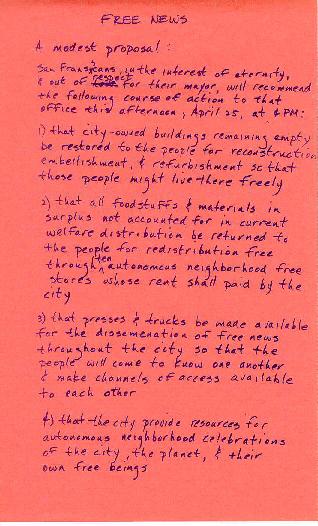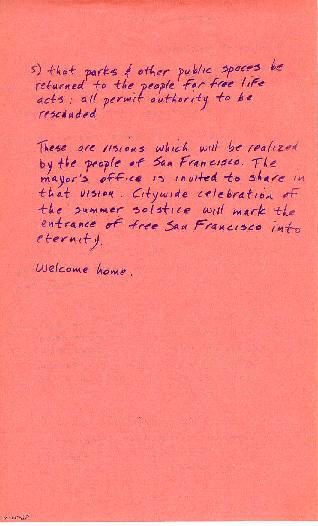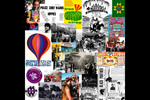The Genesis of NOWSREAL, a film about the San
Francisco Diggers
[Ed. note: it is with deep appreciation that we publish Kelly Hart's
account of the making of Nowsreal in September 2018, exactly fifty years
after the events he describes here. For so long, the genesis of
Nowsreal
was a mystery just as much of the Digger mythos remains mysterious. Now, Kelly has
pulled back that curtain to show us what the film makers were
thinking when they created this unique and important historical
document.]
One peaceful evening when I was living in a small cabin nestled at
the base of some giant redwoods near Monte Rio, along the Russian River
in Sonoma County, California, I heard a deep rumbling sound approaching
up the driveway. I looked out to see what was causing the commotion, and
soon encountered a leather jacketed man riding a Harley Davidson
motorcycle. It turned out to be Billy Fritch, also known as Sweet
William, and he was on a mission from the San Francisco Diggers. He had
been sent to enlist my help in making a movie about the Digger movement.
Evidently, they had already started with the project, but the cameraman
suddenly abandoned them and they were desperate to find a replacement.
I was a budding young filmmaker at the time, in my early twenties,
and trying to establish myself. Up until that time I had completed very
few projects and was thirsty to get some real experience under my belt.
I told Billy that I would think about it and get back to them. He was
satisfied with that and rumbled on down the dark driveway, leaving me to
ponder the situation.
The San Francisco Diggers were not your ordinary organization; in
fact there was very little about them that was organized. They were more
like a collective of radical individuals who wanted to stir up society
and make some drastic changes with how people thought about life and how
it was conducted. This was at the height of the psychedelic revolution
in the late 1960’s and everything was on the table, as far as the
Diggers were concerned.
I decided to go for it, and contacted Peter Berg, one of the central
characters involved with the film concept. I met with him in San
Francisco and he explained that so far they only had a few minutes of
16mm film shot, but had ideas for much more than that. They didn’t
really have a script to work from; what they had were a stack of index
cards with scenes written on them, representing the primary activities
or situations that were emblematic of what the Diggers were about. These
cards were generated in brainstorming sessions involving some of the
luminaries of the Digger movement: along with Peter Berg and Billy
Fritch, was Emmett Grogan, Peter Coyote, Judy Goldhaft, Ron Thelin, and
Lenore Kandel. Many of these folks had been part of the San Francisco
Mime Troupe, and were predisposed to acts of street theater as a mode
for engaging the public in thought-provoking stunts.
The concept for the film was that it would be a sort of patch-work
montage that would of its own force describe what the Diggers were
about. There was to be no narration, or “internal monologue,” as Peter
Berg described it. It was to be a kind of stream-of-consciousness film
that audiences could experience directly, without having to be told how
to perceive it. This approach appealed to my own emerging ideas of how
films could be made, so I embraced the challenge.
I offered to make myself available during the summer of 1968 to run
with the Diggers and document their activities. Whenever something was
happening that folks thought should be part of the film, they would
contact me and I would arrive with my 16mm camera. This was a simple
little Bolex with no sound syncing capability, so what I captured was
just visual. Often Peter Berg would carry an audio tape recorder and
capture sounds that might be useful.
As was central to the Digger philosophy, NOWSREAL was to be available
only for free, and in fact there was basically no budget for the film.
We relied on donations of “end rolls,” the bits of film left over after
professional film crews approached the end of their rolls of raw film. I
would load these onto small reels that fit in my Bolex and expose them
for later development. Somehow we managed to get by on the largesse of
others interested in seeing the success of our enterprise. One such
person was Haskell Wexler, the Hollywood cinematographer, producer and
director, who I later learned was one of the early cameramen involved in
the NOWSREAL project.
By the time that summer had past and we had captured a good
representation of Digger activity, many of the principal actors had
dispersed, including Emmett Grogan and Peter Coyote, leaving Peter Berg
and myself to carry on with finishing the process of making the film.
This is probably just as well, since it takes real concentration and
focused effort to edit a film, and is better done with just a few minds
involved. I had rudimentary 16mm editing equipment set up in my Monte
Rio Cabin, so that is where Peter and I would get together and play with
and assemble the patch-work that was to become NOWSREAL.
Peter brought with him the bag of audio tape he had acquired so we
could use that to fit audio with visual components. There was little
opportunity to try to match these to the extent of creating true lip
synced scenes, but we did attempt this on a few occasions. I remember
having to retard the rate of audio some to get it to match the film.
I feel that the creation of NOWSREAL was one of my most successful
creative collaborations in my limited film career. Peter and I worked
well together, with neither of us dominating the flow of the editing
choices. One of us would suggest trying something, and we would see
whether it worked or not. As the film evolved it seemed to have a mind
of its own, and grew almost organically. I suppose that you could say
that Peter assumed more the role of director and I was more of the
editor, in that Peter was really one of the Diggers, and I was more of
an outsider looking into their world, so Peter had more at stake in the
result.
In keeping with our frugal approach to filmmaking, I had made a
device for doing some basic processing of raw film (I had many years of
experience as a still photographer developing my own negatives.) I had
even made a simple 16mm film printer using parts from an old movie
projector, and I used this to create some of the black and white scenes
of people dancing with an odd “solarized” look.
By the time that we were approaching the end of the project, I had
moved to a rented house in Emeryville, closer to San Francisco, making
it somewhat easier with the logistics of editing. What we had at that
point was an edited workprint and still needed to assemble the original
reversal film in an A/B roll configuration, complete with a separate
16mm audio track, in preparation for striking prints that could be
projected as usual. All of this takes money, which was in short supply.
Haskell Wexler, our savior, came to the rescue and offered to take over
the printing of the film through his professional lab account in Los
Angeles. Peter and I flew to LA at one point to meet with Haskell and
make all of the arrangements. To this day the original A/B rolls are
still in a vault somewhere in Los Angeles.
Now that we had a few prints of the film that could be shown, we
looked for appropriate venues for doing this. The fact that the film was
specifically made to only be shown for free, actually hampered this
effort, because few conventional movie theaters were interesting in
showing films for free. As a consequence, NOWSREAL was projected at
night on the walls of buildings in San Francisco, at parties or
gatherings or in the odd coffee house or bar. I organized showings at
places like libraries or film festivals, but overall, NOWSREAL has
gotten very little exposure.
Over the years, some scenes have been excerpted for inclusion in
other historical documentary films, so NOWSREAL has gained a certain
archival value. Currently it is available for viewing on the Diggers
archival website:
www.diggers.org/nowsreal.htm.
|

Rosana & Kelly Hart
|
A Filmic Odyssey with NOWSREAL
The first time I saw NOWSREAL was at one of the collating
parties that Peter and Judy Berg held in their home in San Francisco's
outer Noe Valley neighborhood after they had started Planet Drum. This
was when Planet Drum was a periodic bundle of printed communiqués sent
in from far-flung correspondents to the central burgeoning bioregional
network that the Bergs would compile and send back out in odd-sized
envelopes always with the iconic Sami shaman figure printed on the
outside of the bundle. Later, Planet Drum would become a Foundation and
Office with an agenda of projects that (to this day) informs the
bioregional movement—itself partly an offshoot of the Digger movement
that first coalesced around the daily Free Feeds in the Panhandle—that
10-block long green strip that played a similar role that public commons
have traditionally provided in the formation of underground and
alternative cultures throughout history.
Over the years, numerous opportunities arose for the showing of the
"digger film". When Samurai Bob got back to San Francisco in 1976 with
Jane Quattlander, they would borrow Peter and Judy's copy (the only one
in existence) and show it on Haight Street at the Red Victorian, that
little cinema where the only seating was a series of deep cushion
couches, more like an intimate bedroom than a movie house. Or they would
take it to one of the anti-nuclear events to raise awareness of the
dangers of Diablo Canyon or Vallecitos or any of the other nuclear
facilities in California, including Livermore Labs where the latest
nuclear weapons were developed. Somehow, the showing of Nowsreal
was a catharsis from the frightening idea of nuclear annihilation.
Inevitably at these events, the increasingly brittle film would break
in the middle of the showing. Bob would carefully splice the two ends
(cutting off a small piece on either side) and tape the whole back
together. Slowly over many showings, cherished scenes from Nowsreal
were disappearing from historical view. In 1978, after coming into a
small windfall of cash, I called Peter and suggested that I would like
to fund the printing of a brand new copy of Nowsreal if such a
thing were possible. For some years, Peter had called me "digger
archivist" so he approved the idea wholeheartedly. I made arrangements
with the Hollywood producer who kept the original positive print in his
vault to have a 16-mm copy made.
Within a few months, the call came to bring this new copy of
Nowsreal out of the darkness and into the light. Country Joe
McDonald was planning a film festival on the Cal campus in Berkeley. He
had contacted Peter Berg who contacted me to see if I would take the new
(complete) 16-mm print to have it shown at Wheeler Auditorium. I'll
never forget the event which was one of those moments that the Universe
throws each of our ways to keep changing perspectives. The audience was
a young Berkeley crowd and all that implies in terms of diverse and
vocal frames of reference. This was 1979, barely more than a decade
since the events that Nowsreal depicted. Up to this time, all the
Nowsreal showings I'd attended had been mostly counterculture
crowds. I knew I wasn’t on Haight Street any longer when a slow hissing
started in the audience during the scene at the Straight Theater where
the camera focuses at certain points on the women dressing and
undressing for their exercise class. The biggest reaction was during the
scene at a remote garbage dump when some of the men on their motorcycles
go for gun practice and chop talk. A sizeable chunk of the Berkeley
crowd got up and left the theater at this point. That was the last time
I brought the print out to show.
Fortunately the invention of VHS and the introduction of the first
commercial VCR by the Japanese corporation JVC in 1976 would solve the
problem of scarcity of an archival resource. In the early 1980s Peter
Berg introduced me to Kelly Hart, the filmmaker who had done the camera
work and editing of Nowsreal. Kelly had gotten a call from a
British film group working on a film retrospective of the Sgt.
Pepper’s Lonely Hearts Club Band album. The film would be released
on June 1, 1987, two decades after the original release of the Beatles
album. The title of the film, “It Was Twenty
Years Ago Today,” referred to one of the lines from the album’s
title cut, as well as the planned release of the film. The British
producers wanted to look at Nowsreal to see if there was footage
they could use (it turned out there wasn’t.) Since I had this virgin
(nearly) copy of Nowsreal, it was arranged that I would take it
to Diner Studios in San Francisco where the producers would pay to have
VHS master copies made, one for Kelly, one for them, and one for the
Digger archive. It’s that VHS master copy from which myriad number of
copies were made. At one point, as part of the ongoing effort of the
Digger Archive to re-release Digger texts, we made several dozen copies
of the VHS tape (with specially designed cover graphic) and distributed
them by hand at solstice and equinox celebrations. Samurai Bob would
have been proud of the effort his enthusiasm had spawned.
Then came the Internet. In 1991, I saw a demonstration of the World
Wide Web by Tim Berners-Lee, the inventor of HTML, at a professional
conference I was attending. When I got home, the first thing I did was
to start working on a web page for the Digger Archives. At that point
there were maybe a hundred web sites in the world. The idea behind the
online archive was to provide access to rare materials to inform and
inspire a generation who had never known the Diggers. That’s still its
main purpose. Finally after many false starts trying to get Nowsreal
converted into web format, it’s done. The quality is not as good as it
could be (in my perfectionist's estimation.) This is after all a fourth generation copy of the original.
Perhaps someday I'll figure out a better way.
—epn 2014-08-13 |

Text of the Free City proclamation depicted in Nowsreal on the
steps of San Francisco City Hall, Apr 25 1968.
 |

